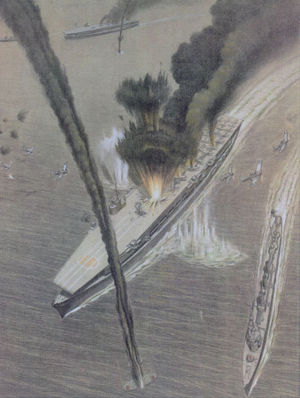Battle of Midway
The Battle of Midway was a critical battle of the Pacific Theater of Operations in the Second World War. Fought in June 1942, it ended Japanese strategic expansion and put them on the long-term defensive.
Its principal objective, from the Japanese standpoint, was to extend their defensive perimeter, which the Doolittle Raid had convinced them was not far enough east. The core Japanese strategy was to lure the American fleet into the Western Pacific, where the Japanese would fight it on terms favorable to them. They saw their island airfields as a key strength of fighting in the Western Pacific.
Concept of operations
ADM Isoroku Yamamoto, commanding the Japanese Combined Fleet, planned a complex operation intending to deceive ADM Chester Nimitz, the U.S. Pacific commander, and split his forces. A large Japanese force was sent north to attack and invade the Aleutian Islands, off Alaska. One important difference is that Nimitz stayed ashore in Hawaii, where he did not need to maintain radio silence and could exert overall control, while Yamamoto was isolated.
Yamamoto sailed with the Main Body, built around a battleship force. The carrier force, under VADM Chuichi Nagumo, preceded them. There was yet another force that carried the Midway invasion unit, as well as supporting submarines and scout aircraft.
Order of battle
Japan
After the Battle of Coral Sea, he had four frontline carriers operational — Sōryū, Kaga, Akagi and Hiryū &mdash. One of the effects of Coral Sea had been to put two of the six carriers that had attacked Pearl Harbor out of service, as well as losing pilots.
United States
Fully operational were the carriers USS Enterprise (CV-6) and USS Hornet (CV-8). USS Saratoga (CV-3) was out of action, undergoing repair after a torpedo attack, and Yorktown sailed after three days' work to repair her flight deck and make essential repairs, with civilian work crews still aboard.
Intelligence preparation
In May, Allied codebreakers discovered Midway was the true target. Nagumo was again in tactical command, but was focused on the invasion of Midway; Yamamoto's complex plan had no provision for intervention by Nimitz before the Japanese expected him. Planned surveillance of the U.S. fleet by long range seaplane did not happen, as a result of an abortive identical operation in March, so U.S. carriers were able to proceed to a flanking position on the approaching Japanese fleet without being detected. Nagumo had 272 planes operating from his four carriers, the U.S. 348 (of which 115 were land-based).
First engagements
As anticipated by American commanders, the Japanese fleet arrived off Midway on June 4 and was spotted by PBY Catalina patrol aircraft. By the time the Japanese had launched planes against the island, U.S. Army Air Force planes had scrambled and were heading for Nagumo's carriers. However, initial U.S. attacks were poorly coordinated, piecemeal, and ineffectual; they failed to score a single hit and half of them were lost. At 09:20 the first carrier aircraft arrived when Hornet's TBD Devastator torpedo bombers attacked; Zero fighters shot down all 15. At 09:35, 15 TBDs from Enterprise skimmed in over the water; 14 were shot down by Zeroes. The carrier aircraft had launched without coordinating their own dive bomber and fighter escort coverage so the torpedo bombers had arrived first, distracted Nagumo's Zeros. When the last of the strike aircraft arrived, the Zeros could not protect his ships against a high-level dive bomber attack.
Decisive action
In addition, his four carriers had drifted out of formation, reducing the concentration of their anti-aircraft fire. In his most-criticized error, although Nagumo ordered aircraft armed for shipping attack as a hedge against discovery of American carriers, he changed arming orders twice, based on reports an additional strike was needed against Midway and the sighting of the American task force, wasting time and leaving his hangar decks crowded with refueling and rearming aircraft and ordnance stowed outside the magazines. [1]
When SBD Dauntless dive bombers from Enterprise and Yorktown appeared at 10,000 feet, the Zeroes at sea level were helpless; the dive bombers sank Sōryū, Kaga, and Akagi. Hiryū survived this wave of attacks and launched an attack against the American carriers which caused severe damage to Yorktown (which was later finished off by a Japanese submarine). A second attack from the U.S. carriers a few hours later sank the Hiryū.
Aftermath
While Yamamoto had hoped for a night gunfire engagement, with his enormous gunnery superiority with the Main Body, RADM Raymond Spruance, in tactical command, refused that fight. Spruance felt his responsibility was continuing the defense of Midway, but also conserving his depleted resources.
